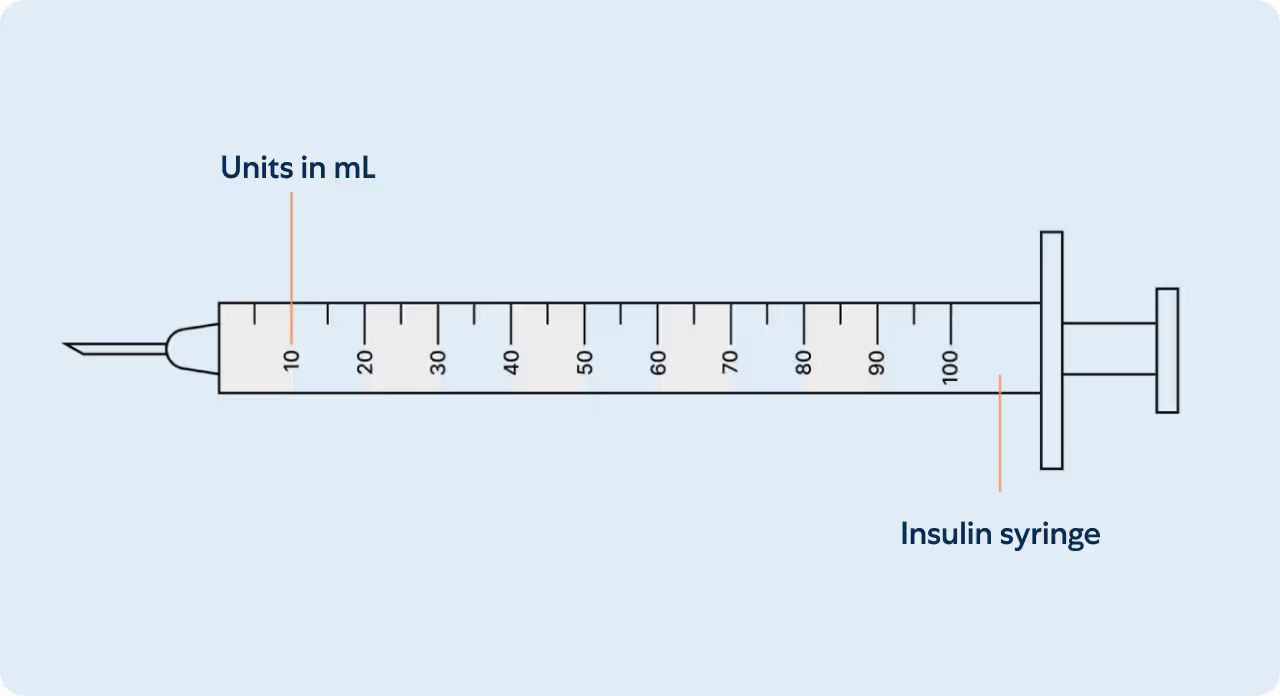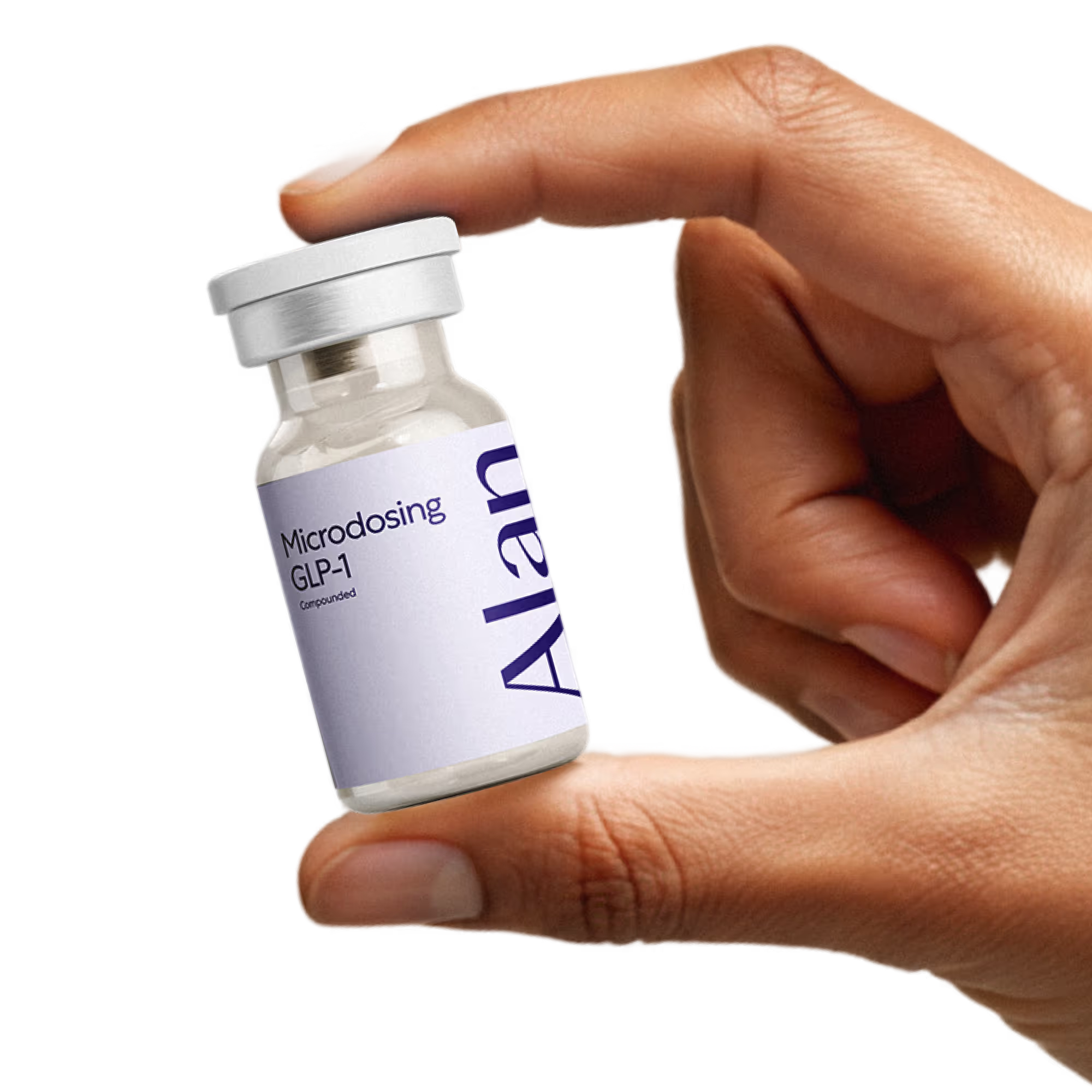Storage
Always refrigerate your vial at 36–46 °F (2–8 °C), never freeze it, and avoid storing it next to the cooling element. Protect your vials from direct sunlight and heat.
Instructions
This information is intended for individuals who have been prescribed Microdosing Compounded Semaglutide by their Alan Health provider.
Inject once per week as directed by your healthcare provider using a vial and syringe.
{{injection-video}}
Clean the injection site, insert the needle at a 45–90-degree angle, and inject the medication slowly. Hold until fully administered. Rotate injection sites daily to avoid irritation.
- Prep Your Supplies: Wash hands and gather the liraglutide vial, insulin syringe, alcohol swabs, and a sharps container. Inspect the solution—it should be clear and free of particles.
- Draw the Dose: Clean the rubber top of the vial with an alcohol swab. Inject air into the vial equal to your prescribed dose, then draw up the exact amount. Remove any air bubbles by tapping the syringe and pushing gently on the plunger.
- Pick an Injection Site: Use the abdomen (at least 2 inches from the belly button), thigh, or upper arm. Clean the area with an alcohol swab and allow it to dry completely.
- Inject: Gently pinch the skin. Insert the needle at a 45–90° angle, depending on needle length and body type. Inject the medication slowly and steadily. Once done, remove the needle and apply gentle pressure with a clean swab. Dispose of the syringe safely in a sharps container.
If your medication has a seal, watch this video to learn how to remove it.
To learn how to inject your medication subcutaneously, please watch this video.
Missed Dose? If you miss a dose, skip the missed dose and continue with your regular schedule.
Understanding your insulin syringe

Measuring your dose
Insulin syringes are used for subcutaneous injections. They are marked in Units on the insulin syringe barrel (see illustration). Insulin syringes facilitate the precise measurement of tiny amounts of liquids which are ideal for medications such as insulin that require small and accurate dosing. Unit marks are also expressed in mL’s and can be interchangeably referenced. A prescriber may write a prescription in Units or in mL’s.
Within the amount of liquid is the prescribed mg dosage of your medication (see mg chart). Milligrams (mg) is not an amount of liquid, but rather the amount of drug that is within. The conversion between units and milligrams varies depending on the concentration of the product being used.
What can I expect?
Safety information
The most common side effects include nausea, vomiting, and diarrhea.
In rare cases, side effects include pancreatitis and thyroid tumors. Seek immediate medical care if these occur.
A full list of side effects can be found here.
Indications
Semaglutide is a prescription GLP-1 receptor agonist indicated:
- As an adjunct to a reduced-calorie diet and increased physical activity for chronic weight management in adults with a body mass index (BMI) ≥30 kg/m² (obesity), or ≥27 kg/m² (overweight) in the presence of at least one weight-related comorbidity (e.g., hypertension, type 2 diabetes, or dyslipidemia).
BLACK BOX WARNING: Risk of Thyroid C-Cell Tumors
In animal studies, semaglutide caused thyroid C-cell tumors, including medullary thyroid carcinoma (MTC). It is unknown whether semaglutide causes thyroid C-cell tumors, including MTC, in humans.
Do not use semaglutide if you:
- Have a personal or family history of MTC or Multiple Endocrine Neoplasia syndrome type 2 (MEN 2)
- Are pregnant or planning to become pregnant without consulting your healthcare provider.
Contraindications
Do not take semaglutide if you:
- Have a personal or family history of MTC or MEN 2.
- Have a known hypersensitivity to semaglutide or any of its components.
- Are pregnant or planning to become pregnant.
- Are breastfeeding or planning to breastfeed.
- Have a history of pancreatitis.
- Have type 1 diabetes mellitus.
- Have severe gastrointestinal disease, including gastroparesis or intestinal obstruction.
- Are currently taking another GLP-1 receptor agonist or another semaglutide-containing product.
Warnings and Precautions
- Pancreatitis: Acute pancreatitis, including fatal and non-fatal hemorrhagic or necrotizing pancreatitis, has been reported. Discontinue if pancreatitis is suspected.
- Gallbladder Disease: Increased risk of gallstones and cholecystitis. Monitor for symptoms such as abdominal pain or jaundice.
- Hypoglycemia: When used with insulin or insulin secretagogues (e.g., sulfonylureas), hypoglycemia may occur. Monitor glucose levels closely and adjust doses accordingly.
- Renal Impairment: Cases of acute kidney injury have been reported, usually in the context of gastrointestinal side effects like vomiting and diarrhea. Monitor renal function, especially in susceptible individuals.
- Diabetic Retinopathy Complications: Rapid improvements in glucose control may worsen retinopathy. Monitor patients with pre-existing retinopathy.
- Heart Rate Increase: An increase in resting heart rate has been observed. Monitor periodically.
- Suicidal Behavior and Ideation: Monitor for depression, mood changes, or suicidal thoughts. Discontinue if such symptoms occur.
- Hypersensitivity Reactions: Severe allergic reactions, including anaphylaxis and angioedema, have occurred. Discontinue immediately if hypersensitivity is suspected.
- Aspiration Risk: Like other GLP-1s, semaglutide may increase the risk of aspiration during anesthesia. Inform the surgical team prior to procedures.
Drug Interactions and Limitations of Use
- Semaglutide slows gastric emptying and may affect the absorption of oral medications. Monitor when co-administering with oral drugs requiring rapid absorption.
- Do not use in combination with other semaglutide-containing products or GLP-1 receptor agonists.
Reproductive Considerations
- Pregnancy: Semaglutide should be discontinued at least 2 months prior to a planned pregnancy due to its long half-life. Weight loss during pregnancy is not recommended.
- Breastfeeding: Avoid use while breastfeeding unless specifically advised by a healthcare provider.
To Report Adverse Reactions, Contact the FDA:
- Phone: 1-800-FDA-1088
- Online: www.fda.gov/medwatch
Disclaimer
These statements are intended for informational purposes and do not replace professional medical advice. Always consult your healthcare provider with any questions about semaglutide or your medical condition.
Note: The above statements have not been evaluated by the Food and Drug Administration. This product is not intended to diagnose, treat, cure, or prevent any disease.
Frequently Asked Questions
What is Microdosing GLP-1?
Microdosing GLP-1 is a low-dose protocol using either oral or injectable GLP-1 medication to support long-term health and wellness. By starting with small, gradual doses, this approach aims to promote benefits like improved energy, cognitive function, and metabolic balance—while minimizing potential side effects.
How do you microdose with GLP-1?
Microdosing GLP-1 involves taking small doses—either as oral drops placed under the tongue or as a subcutaneous injection into the fatty layer of skin (such as the abdomen or thigh). Your provider will guide you on the dosing schedule best suited to your wellness goals.
What are the potential benefits of Microdosing GLP-1?
Microdosing GLP-1 is designed to support long-term wellness and healthy aging. By using low, consistent doses, it may help boost energy, improve mood and focus, support cardiovascular and metabolic health, reduce inflammation, and enhance cellular function—all while minimizing the side effects often associated with higher-dose GLP-1 protocols.
This gentle approach is ideal for individuals seeking longevity and wellness benefits.
How long will it take to notice benefits?
Results vary depending on health and lifestyle factors. Most people report feeling more balanced within the first few weeks, with improvements in energy, clarity, and overall wellness. Staying consistent with your schedule is key.
How is microdosing different from standard GLP-1 use?
Microdosing typically uses lower doses than those prescribed for diabetes or weight management, focusing instead on promoting daily wellness and metabolic balance. Dosing strategies can vary based on individual goals.
Is Microdosing GLP-1 for weight loss?
Microdosing GLP-1 is not intended for weight loss. If weight loss is your primary goal, we recommend exploring our weight loss treatments here!
Is it safe to travel with?
Absolutely! As long as you store the medication as recommended in your instructions (if prescribed), you can safely travel with your GLP-1 prescription. Please note injectable GLP-1 must be refrigerated. Use a temperature-controlled storage container to maintain the quality of your medication throughout your trip, even if your medication is stable at room temperature.
Additional support
For details about your medication and dosing, please log in to your patient portal. Your physician is here to help with any medical questions. If you are experiencing a medical emergency, call 911 right away.











